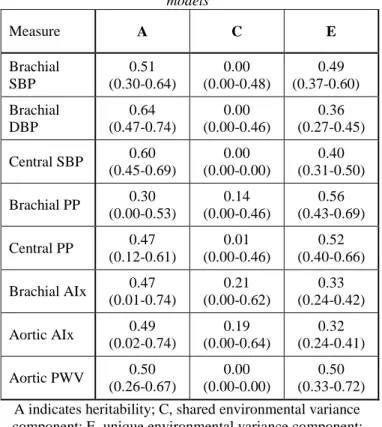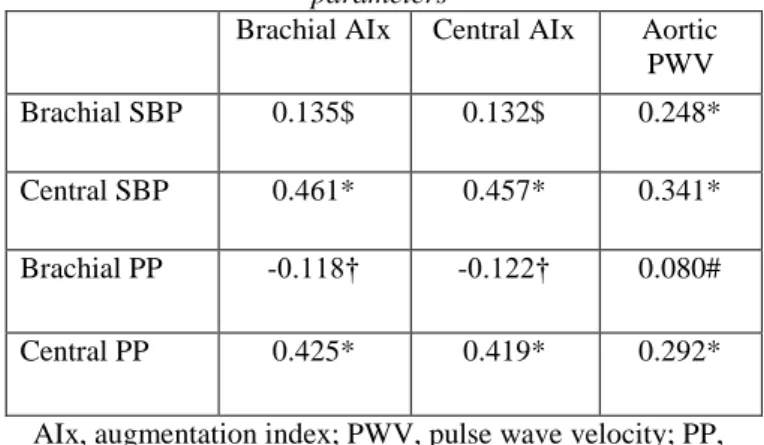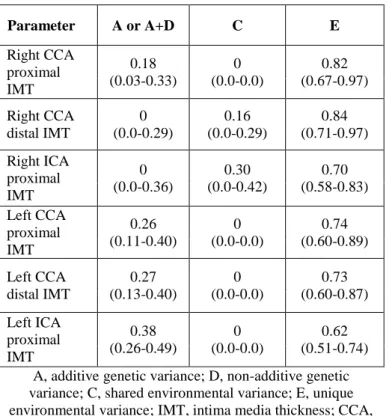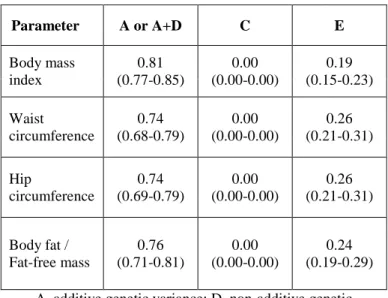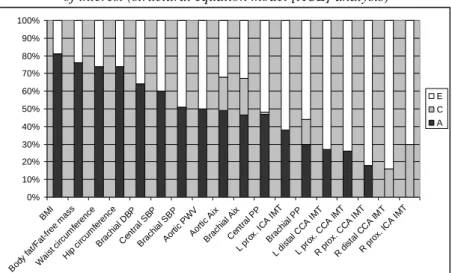Cardiovascular and anthropometric twin studies Ph.D. Thesis
Ádám Domonkos Tárnoki, M.D.
Semmelweis University School of Ph.D. Studies, Basic Medicine
Supervisor: Viktor Bérczi, M.D., Ph.D., D.M.Sc.
Opponents: Attila Cziráki, M.D., Ph.D.
Zsuzsanna Putz, M.D., Ph.D.
Chairman of the Exam Committee:
Professor András Falus, M.D., Ph.D., D.M.Sc.
Members of the Exam Committee:
Pál Ákos Deák M.D., Ph.D Pál Maurovich-Horvát M.D., Ph.D Pál Soltész M.D., Ph.D
Zoltán Süttő M.D., Ph.D Budapest
2013
1. Introduction
Blood pressure regulation involves complex interactions among genetic and nongenetic factors, providing major challenges to dissection of the genetic components that influence blood pressure. New risk factors have been determined in 2007 Guidelines for the Management of Arterial Hypertension including increased arterial stiffness.
Arterial stiffness is a dynamic property, determined both by vascular function like vascular smooth muscle tone and by the structure of the vessel wall like elastin/collagen content.
Beyond certain hemodynamic variables, carotid intima-media thickness (IMT) is also a surrogate marker for atherosclerosis, and is associated with prevalent and incident cardiovascular disease.
Obesity is a complex condition of excessive fat accumulation linked to major adverse health effects including the development of cardiovascular disease. Underlying mechanisms of the rising obesity epidemic are still unclear. It is also under investigation why not everyone becomes obese and there is considerable variation in individual responsiveness to obesogenic environments.
Although there is a consensus that genetic factors play a role in atherogenesis, the precise magnitude of the genetic influence and association of hemodynamic traits (arterial stiffness, central systolic blood pressure, pulse pressure, carotid IMT) and heritability of anthropometric risk factors is poorly described. Twin studies by comparing identical with non-identical twins produce information on the relative contribution of genes and environment, and how the two interact. The development or the progression of a heritable phenotype predisposing to a disease can be avoided or postponed, if proper screening methods are available. On the other hand, if the unique environmental factors determinate the certain trait, prevention (eg., by the modification of lifestyle) must be highlighted.
2. Aims
Our main aim was to investigate the contribution of genetic and environmental factors to the development of certain cardiovascular and anthropometric phenotypes. The aims of the investigations themselves were as follows:
1. Although the heritability of few „traditional”
hemodynamic variables has been shown, the precise magnitude of the genetic influence on novel hemodynamic variables (eg., central systolic blood pressure /SBP/, pulse pressure /PP/, arterial stiffness) and the association of arterial stiffness with central SBP and PP is poorly described. The first goal of our investigation was to assess the heritability of arterial stiffness, central SBP and PP and of brachial PP and the phenotypic/genotypic correlations between central pressure and arterial stiffness measures using a twin sample.
2. Previous studies have shown that carotid IMT is determined by genetic factors on limited segments. However, the precise extent to which genetic predisposition explains the variance of carotid IMT on multiple segments in a wide age- range population is unclear. In addition, it is poorly investigated what connection is between carotid IMT and arterial stiffness measures. The second goal of this investigation, was to assess the heritability of carotid IMT, and to estimate phenotypic correlations between carotid IMT and arterial stiffness and augmentation index measures.
3. Several studies have investigated the interplay of genetic and environmental influences on anthropometric parameters related to obesity by studying twin cohorts. In this study, we aimed to assess body composition components by using bioelectrical impedance analysis to determine the heritability of key anthropometric attributes in twins. Our goal was to demonstrate the ease with which this relatively simple method may confirm the role of genetics in body composition attributes and prove practical in identifying individuals who would primarily benefit from lifestyle changes to prevent obesity-related adverse health events.
3. Subjects and methods 3.1 Subjects
In this classical twin study, we examined in total 391 twin pairs, including 166 Hungarian (59 dizygotic, DZ and 107 monozygotic, MZ, mean age 42±17 years±standard deviation /SD/), 50 American (3 DZ and 47 MZ, age 46±17 years) and 175 Italian (97 DZ and 78 MZ, age 55±12 years) pairs. In the three substudies, different sample sizes were included in the analysis as follows (Table 1):
Table 1. Basic sample characteristics of the three studies Hemodyna-
mic study
Carotid IMT study
Anthro- pometric
study
Subjects, n 392 410 760
Monozygotic:
dizygotic, n
308:84 270:140 460:300
Male:female 90:302 127:283 241:519
Age, years
(mean±SD) 43.4±17.0 49.0±16.4 49.1±15.4
3.2 Study design
Adult subjects were recruited as part of the International Twin Study 2009 project. Exclusion criteria were race other than white (to exclude the influence of ethnicity), pregnancy, medical conditions possibly interfering with compliance during test procedures, arrythmia, morbid obesity, and anorexia. Hungarian subjects were enrolled from our Hungarian Twin Registry and examined during local twin festivals (at locations in Ágfalva and Szigethalom) and in two large hospitals in Budapest (Semmelweis University Department of Radiology and Oncotherapy; Military Hospital
Department of Cardiology) between July, 2009 and June, 2010. Italian twins were enrolled by the Italian Twin Registry and tested in Roman, Paduan, and Perugian hospitals in September, 2009 and in March, 2010. American twins were tested at the Twins Day Festival in Twinsburg, OH, USA in August, 2009. In the absence of genotypic data, zygosity was assessed through a widely used and accepted self-reported questionnaire.
3.3 Hemodynamic measurement
Aortic pulse wave velocity (PWV), brachial and aortic augmentation index (AIx) along with central blood pressure components can be assessed using Arteriograph (Medexpert Ltd., Budapest), a clinically validated oscillometric device which has been favorably compared with intra-arterial invasive measurements. The measurements were performed in accordance with the suggestions of the European Society of Cardiology. All subjects were asked to refrain from smoking 3 hours, eating 1 hour, drinking alcohol and coffee 10 hours prior to their visit. Subjects were examined in supine position on the dominant arm after at least 10 min of rest, and were asked not to speak or move during the measurements, and to keep their eyes closed during the test.
3.4 Carotid ultrasonography
The measurement of carotid IMT was performed by B- mode ultrasound with linear array high frequency (5-10 MHz) transducers (in Rome: Esaote Technos MPX, in Padua:
Philips iU22, in Perugia: Esaote Technos MP, in Hungary:
Toshiba Power Vision and Esaote Mylab70, in the USA:
Sonosite Titan). Sonographers were professional internists, neurologists or radiologists. IMT of proximal and distal common carotid artery, and of proximal internal carotid artery was measured bilaterally with standard techniques.
3.5 Assessment of body composition
Body composition was determined by a clinically validated, portable body consistency monitor (OMRON BF500, Omron Healthcare Ltd., Kyoto, Japan) using bioelectrical impedance analysis (BIA). The monitor leads weak electrical current of 50 kHz and less than 500 μA through the subject’s body to determine the amount of fat tissue. Weight, body fat percentage and fat-free mass was obtained. Waist and hip circumferences were measured by a measuring tape.
3.6 Statistical analysis
3.6.1. Risk factor assessment
Initially we conducted a descriptive analysis (mean, standard deviation and the percentage for categorical variables) in MZ and DZ twins. Between-sex, between- zygosity and between-country differences were calculated using independent-samples t-test. The heritability model corrected for country of sample by regressing out its effects as these differences were significant at p<0.05.
3.6.2. Estimating genetic influence on hemodynamic, carotid intima-media thickness and body composition parameters
A descriptive estimate of the genetic influence was calculated using the bivariate co-twin correlation in MZ and DZ pairs for each trait of interest. If the within pair similarity for a phenotype is greater in MZ than DZ pairs this provides evidence for genetic influence. Univariate quantitative genetic model (ACE) was performed to decompose phenotypic variance of the considered parameters into additive (A), common environmental (C) and unique environmental (E) effects. The additive genetic component measures the effects due to genes at multiple loci or multiple alleles at one locus.
In case of carotid IMT and anthropometric parameters, non-
additive or dominant (D) genetic component was also calculated which component measures the interaction between alleles at the same locus or on different loci. The common environmental component estimates the contribution of the shared family environment by both twins, whereas the unique environmental component estimates the effects that apply only to each individual twin, and includes measurement error. Model fitting was done with the statistical software Mplus Version 6, Mx and STATA softwares.
3.6.3. Estimating the correlation between arterial stiffness and carotid intima-media thickness parameters
Correlation coefficients (CC) between brachial AIx or aortic PWV and carotid IMT variables were calculated to measure the strength and the direction of the relationship between variables.
3.6.4. Genetic covariance between hemodynamic variables
A bivariate Cholesky decomposition was carried out to derive the magnitude of covariation between the investigated phenotypes of interest and to estimate what proportion of this correlation is attributable to common underlying genetic and environmental factors.
4. Results
4.1 Results of the hemodynamic twin study 4.1.1 Genetic and environmental effects on
hemodynamic components
Age-, sex- and country-adjusted heritability of hemodynamic parameters ranged between 30% and 64%.
Shared environmental factors had negligible influence.
Unshared environmental effects accounted for the largest part of the environmental variance (Table 2).
Table 2. Age-, sex- and country-adjusted parameter estimates and 95% confidence intervals of the best-fitting univariate
models
Measure A C E
Brachial SBP
0.51 (0.30-0.64)
0.00 (0.00-0.48)
0.49 (0.37-0.60) Brachial
DBP
0.64 (0.47-0.74)
0.00 (0.00-0.46)
0.36 (0.27-0.45) Central SBP 0.60
(0.45-0.69)
0.00 (0.00-0.00)
0.40 (0.31-0.50) Brachial PP 0.30
(0.00-0.53)
0.14 (0.00-0.46)
0.56 (0.43-0.69) Central PP 0.47
(0.12-0.61)
0.01 (0.00-0.46)
0.52 (0.40-0.66) Brachial AIx 0.47
(0.01-0.74)
0.21 (0.00-0.62)
0.33 (0.24-0.42) Aortic AIx 0.49
(0.02-0.74)
0.19 (0.00-0.64)
0.32 (0.24-0.41) Aortic PWV 0.50
(0.26-0.67)
0.00 (0.00-0.00)
0.50 (0.33-0.72) A indicates heritability; C, shared environmental variance component; E, unique environmental variance component;
PP, pulse pressure; SBP, systolic blood pressure; DBP, diastolic blood pressure; AIx, augmentation index; PWV,
pulse wave velocity.
4.1.2 Phenotypic correlation between brachial and central blood pressure, pulse pressure and arterial stiffness
In a bivariate saturated model, both central SBP and PP had strong correlations with brachial and central AIx, as well as with aortic PWV (all p<0.001). Brachial PP had a weak correlation with brachial AIx (p<0.05) and central AIx (p<0.05) (Table 3).
Table 3. Bivariate family, age, sex and population corrected phenotypic correlation from a bivariate structural
equation saturated model of a genetic covariance decompistion model between brachial blood pressure, central
blood pressure, pulse pressure and arterial stiffness parameters
Brachial AIx Central AIx Aortic PWV
Brachial SBP 0.135$ 0.132$ 0.248*
Central SBP 0.461* 0.457* 0.341*
Brachial PP -0.118† -0.122† 0.080#
Central PP 0.425* 0.419* 0.292*
AIx, augmentation index; PWV, pulse wave velocity; PP, pulse pressure; SBP, systolic blood pressure
* p<0.001, $ p=0.01, † p<0.05, # non significant
4.1.3 Genetic covariance of brachial and central blood pressure, pulse pressure and arterial stiffness
Since the heritability and bivariate correlation coefficients of brachial and central PP, AIx, central SBP and aortic PWV showed moderate and significant genetic influence, bivariate Cholesky decomposition model was run in order to investigate a common genetic background of these traits. Additive genetic component significantly (p<0.05) accounted for 83-100% of covariance between central PP, brachial SBP, central SBP and aortic PWV. Furthermore, the unique environmental component accounted for 28-36% of the covariance between central PP, central SBP and AIx.
4.2 Results of the carotid IMT twin study
4.2.1 Genetic and environmental effects on carotid IMT
Heritability was estimated to be 18-38% for most of the carotid IMT traits. As regards distal right CCA and proximal right ICA, no genetic effects were detected (Table 4).
Table 4. Standardized genetic and environmental variance components of carotid IMT values and 95% confidence
intervals
A, additive genetic variance; D, non-additive genetic variance; C, shared environmental variance; E, unique environmental variance; IMT, intima media thickness; CCA,
common carotid artery; ICA, internal carotid artery
Parameter A or A+D C E
Right CCA proximal IMT
0.18 (0.03-0.33)
0 (0.0-0.0)
0.82 (0.67-0.97) Right CCA
distal IMT
0 (0.0-0.29)
0.16 (0.0-0.29)
0.84 (0.71-0.97) Right ICA
proximal IMT
0 (0.0-0.36)
0.30 (0.0-0.42)
0.70 (0.58-0.83) Left CCA
proximal IMT
0.26 (0.11-0.40)
0 (0.0-0.0)
0.74 (0.60-0.89) Left CCA
distal IMT
0.27 (0.13-0.40)
0 (0.0-0.0)
0.73 (0.60-0.87) Left ICA
proximal IMT
0.38 (0.26-0.49)
0 (0.0-0.0)
0.62 (0.51-0.74)
4.2.2 Correlation between carotid IMT variables and arterial stiffness and augmentation index
Overall the estimated coefficients indicated a not significant linear correlation. After adjusting for age, correlations between carotid IMT, AIx and PWV appeared indicating only an age-related association.
4.3 Results of anthropometric twin study
4.3.1 Univariate model describing the heritability of body composition
A large proportion of the total variance for all parameters is attributable to genetic factors between 74% and 82% (Table 5). No role of non-additive genetic variance was found. The AE model was the best model. Therefore, common environmental effects had no impact on total variance of all the parameters considered; unique environmental effects instead were estimated as between 19%
and 26% with regard to each parameter.
Table 5. Best-fitting ACE/ADE model of body composition variables and 95% confidence intervals
A, additive genetic variance; D, non-additive genetic variance; C, shared environmental variance; E, unique
environmental variance
4.4 Summary of the univariate model results
The anthropometric parameters showed the highest genetic influence (74-82%). Moderate genetic influence was observed concerning the hemodynamic variables (30-60%).
The heritability of central variables was always higher than one of the brachial (peripheral) values (eg., SBP, PP, AIx).
Genetics had the lowest proportion of total phenotypic variance in carotid IMT parameters ranging between 0% and 38% (Figure 1).
Parameter A or A+D C E
Body mass index
0.81 (0.77-0.85)
0.00 (0.00-0.00)
0.19 (0.15-0.23) Waist
circumference
0.74 (0.68-0.79)
0.00 (0.00-0.00)
0.26 (0.21-0.31) Hip
circumference
0.74 (0.69-0.79)
0.00 (0.00-0.00)
0.26 (0.21-0.31) Body fat /
Fat-free mass
0.76 (0.71-0.81)
0.00 (0.00-0.00)
0.24 (0.19-0.29)
Figure 1. Mean values of additive genetic (A, black), common (C, grey) and unique environmental (E, white) influences on cardiovascular and anthropometric phenotypes
of interest (structural equation model [ACE] analysis)
0%
10%
20%
30%
40%
50%
60%
70%
80%
90%
100%
BMI
Body fat/Fat-free mass Waist circu
mference Hip circu
mference Brachial DBP
Central SBP Brachial SBP
Aortic PWV Aortic Aix
Brachial Aix Central PP
L prox.
ICA IMT Brachial PP
L distal CCA IM T
L prox. CCA IM T
R prox. CCA IM T
R distal CCA IM T
R prox. ICA IMT E C A
BMI, body mass index; DBP, diastolic blood pressure; SBP, systolic blood pressure; PWV, pulse wave velocity; AIx, augmentation index; PP, pulse pressure; L, left; R, right; ICA,
internal carotid artery; CCA, common carotid artery; IMT, intima-media thickness
5. Conclusions
1. Central systolic and pulse pressures, brachial pulse pressure, augmentation index, aortic pulse wave velocity are moderately heritable. Unique environmental factors account for the moderate proportion of variance. A moderate genetic covariance among aortic PWV and central PP, central SBP and brachial SBP was found. The shared genetic background was stronger between aortic PWV and central PP rather than brachial PP. These findings may further highlight the genetic and environmental etiology of vascular aging and the importance of early
atherosclerosis screening, detection and prevention in high- risk patients. Noninvasive estimation of central blood pressure may be a valuable tool for risk stratification and the management of hypertension and increased arterial stiffness to guide appropriate therapeutic strategies at an early stage in order to reverse damage by „de-stiffening”.
Accordingly, these findings may possibly yield to a practical implementation for necessary preventive and therapeutic interventions. Our finding, that strong genetic covariance is present between aortic PWV and central PP rather than brachial PP indicates that genetic factors may affect small arteries, large arteries, and the aorta to a common extent. Besides, the experienced genetic covariances should encourage performance of further genetic studies on the structural components of the arterial wall involved in arterial stiffening.
2. The carotid intima-media thickness parameters appeared to be only moderately or negligible influenced by genetic factors. Environmental factors of relevance for these measures appeared not to be shared within family but related to individual experience. Carotid intima-media thickness did not correlate with arterial stiffness and augmentation index. The moderate genetic influence on most of carotid IMT traits (18-38%) may play a role in early detection of initial atherosclerosis. Consequently, individuals with a positive family medical history of (early) cardiovascular diseases could be screened by carotid ultrasound already in young adulthood to prevent or postpone serious consequences related to increased carotid IMT. Increased carotid IMT could be prevented or postponed if the underlying unshared environmental factors, which are largely responsible for these traits, could be appropriately managed in high-risk patients. The insignificant correlation between the carotid IMT. PWV and AIx variables indicate that increased arterial stiffness and pulse wave reflection is unaccompanied with increased
carotid IMT. Accordingly, endothelial dysfunction is an early phase of atherosclerosis which does not necessarily accompanies with morphological changes in our healthy cohort.
3. Bioelectrical impedance analysis applied to this twin cohort provides additional evidence to the heritability of anthropometric attributes related to obesity. Heritability of weight, waist and hip circumferences, body fat percentage, fat-free mass and body mass index ranged between 74%
and 82%. The completely environmental model showed no impact of shared environmental effects on the variance, while unshared environmental effects were estimated as between 18% and 26%. Our findings provide new evidence that routine use of a portable device to perform bioelectrical impedance analysis is a convenient, noninvasive way to routine assessment of key anthropometric parameters.
Individuals with a positive family history of obesity may need to be monitored during their young adulthood to detect body composition attributes that indicate the development of obesity and the need for life-style changes to reduce the impact of environmental challenges and prevent obesity-associated co-morbidities.
6. List of publications
6.1 Publications related to the current PhD thesis
Tarnoki AD, Tarnoki DL, Stazi MA, Medda E, Cotichini R, Fagnani C, Nisticò L, Lucatelli P, Boatta E, Zini C, Fanelli F, Baracchini C, Meneghetti G, Osztovits J, Jermendy G, Préda I, Kiss RG, Littvay L, Metneki J, Horvath T, Karlinger K, Lannert A, Yang EY, Nambi V, Molnar AA, Berczi V, Garami Z. (2011) Twins lead to the prevention of atherosclerosis. Preliminary findings of International twin study 2009. J Vasc Ultras., 35(2): 61-71.
Tarnoki AD, Tarnoki DL, Stazi MA, Medda E, Cotichini R, Nisticò L, Fagnani C, Lucatelli P, Boatta E, Zini C, Fanelli F, Baracchini C, Meneghetti G, Osztovits J, Jermendy G, Préda I, Kiss RG, Metneki J, Horvath T, Karlinger K, Racz A, Lannert A, Molnar AA, Littvay L, Garami Z, Berczi V, Schillaci G. (2012) Heritability of central blood pressure and arterial stiffness: a twin study. J Hypertens., 30(8): 1564- 1571. (IF = 4,021)
Tarnoki AD, Tarnoki DL, Medda E, Cotichini R, Stazi MA, Fagnani C, Nisticò L, Lucatelli P, Boatta E, Zini C, Fanelli F, Baracchini C, Meneghetti G, Schillaci G, Osztovits J, Jermendy G, Kiss RG, Préda I, Karlinger K, Lannert A, Metneki J, Molnar AA, Garami Z, Berczi V, Halasz I, Baffy G. (2012) Bioimpedance analysis of body composition in an international twin cohort. In Press: Obes Res Clin Pract., doi:10.1016/j.orcp.2012.09.001 (IF = 0,324)
6.2 Publications not related to the current PhD thesis Baffy G, Tarnoki DL, Tarnoki AD, Baffy N. (2009) Colorectalis rákszűrés: Az amerikai tapasztalat tanulságai.
Magyar Radiológia, 83(3): 164-173.
Tarnoki AD, Tarnoki DL, Travers M, Hyland A, Dobson K, Mechtler L, Cummings K. (2009) Tobacco smoke is a major source of indoor air pollution in Hungary’s bars, restaurants and transportation venues. Clinical and Experimental Medical Journal, 3(1): 131-138.
Tarnoki DL, Tarnoki AD, Hyland A, Travers MJ, Dobson K, Mechtler L, Cummings KM. (2010) Measurement of indoor smoke pollution in public places in Hungary. Orv Hetil., 151(6): 213-219.
Tarnoki DL, Tarnoki AD, Travers MJ, Mechtler L, Tamas L, Cummings KM. (2010) Compliance Still a Problem with No Smoking Law. Tob Control., 19(6): 520.
Tarnoki AD, Tarnoki DL. (2010) Krónikus veseelégtelenség kardiovaszkuláris szövődményei a családorvosi gyakorlatban.
Cardiologica Hungarica, 40: 120-128.
Metneki J, Tarnoki AD, Tarnoki DL, Littvay L, Czeizel A.
(2011) Psychosexual study of communist era Hungarian twins. Twin Res Hum Genet., 14(2): 144-149. (IF = 1.701) Osztovits J, Horvath T, Littvay L, Steinbach R, Jermendy A, Tarnoki AD, Tarnoki DL, Metneki J, Kollai M, Jermendy G.
(2011) Effects of genetic versus environmental factors on cardiovascular autonomic function: a twin study. Diabetic Medicine. Diabet Med., 28(10): 1241-1248. (IF = 2.902) Jermendy G, Horváth T, Littvay L, Steinbach R, Jermendy AL, Tarnoki AD, Tarnoki DL, Métneki J, Osztovits J. (2011) Effect of genetic and environmental influences on cardiometabolic risk factors: a twin study. Cardiovasc Diabetol., 10: 96. (IF = 3.346)
Jermendy G, Littvay L, Steinbach R, Jermendy A, Tarnoki AD, Tarnoki DL, Métneki J, Osztovits J. (2011) Heritability of the risk factors for the metabolic syndrome: a twin study.
Orv Hetil., 152(32): 1265-1271.
Jermendy G, Horváth T, Littvay L, Steinbach R, Jermendy ÁL, Tarnoki AD, Tarnoki DL, Métneki J, Osztovits J. (2011) Genetikai és környezeti tényezők szerepe a kardiometabolikus kockázati tényezők alakulásában: ikervizsgálatok eredményei.
Metabolizmus, 9: 304-309.
Bata P, Tarnoki DL, Tarnoki AD, Domjan Z, Buzogany I, Berczi V. (2012) Essential role of using virtual pyeloscopy in
the diagnosis of small satellite renal pelvic tumour in solitary kidney patient. Can Urol Assoc J., 6(5): E195-198. (IF = 1.237)
Bata P, Tarnoki AD, Tarnoki DL, Horvath E, Berczi V, Szalay F. (2012) Acute severe thrombocytopenia following non-ionic low-osmolarity intravenous contrast medium injection. Korean J Radiol., 13(4): 505-509. (IF = 1.538) Tarnoki AD, Tarnoki DL, Bata P, Littvay L, Osztovits J, Jermendy G, Karlinger K, Lannert A, Preda I, Kiss RG, Molnar AA, Garami Z, Baffy G, Berczi V. (2012) Heritability of nonalcoholic fatty liver disease and association with abnormal vascular parameters: A twin study. Liver Int., 32(8): 1287-1293. (IF = 3.824)
Tarnoki DL, Tarnoki AD, Lazar Z, Karlinger K, Molnar AA, Garami Z, Berczi V, Horvath I. (2012) Characteristics of smoking and secondhand smoke exposure in monozygotic and dizygotic twins: results from an international twin study.
Orv. Hetil., 153: 1556-1563.
Tarnoki AD, Baracchini C, Tarnoki DL, Lucatelli P, Boatta E, Zini C, Fanelli F, Molnar AA, Meneghetti G, Stazi MA, Medda E, Cotichini R, Nistico L, Fagnani C, Osztovits J, Jermendy G, Preda I, Kiss RG, Metneki J, Horvath T, Pucci G, Bata P, Karlinger K, Littvay L, Berczi V, Garami Z, Schillaci G. (2012) Evidence for a strong genetic influence on carotid plaque characteristics: an international twin study.
Stroke, 43(12): 3168-3172. (IF = 5.729)
Littvay L, Métneki J, Tarnoki AD, Tarnoki DL. (2013) The Hungarian Twin Registry. Twin Res Hum Genet., 16(1):185- 189. (IF = 1.701)
Molnár AA, Tarnoki AD, Tarnoki DL, Kulcsár Z, Littvay L, Garami Z, Préda I, Kiss RG, Bérczi V, Lannert Á, Monos E,
Nádasy GL. (2013) Heritability of Venous Biomechanics.
Arterioscler Thromb Vasc Biol., 33(1): 152-157. (IF = 6.368)
Tarnoki DL, Tarnoki AD, Nemeth K, Bata P, Berczi V, Karlinger K. (2013) Partial absence of superior vena cava in an adult patient: A case report and review of the literature.
Herz, 2013 Jan 18. [Epub ahead of print] (IF = 0.924) Tarnoki DL, Tarnoki AD, Lazar Z, Medda E, Littvay L, Cotichini R, Fagnani C, Stazi MA, Nisticó L, Lucatelli P, Boatta E, Zini C, Fanelli F, Baracchini C, Meneghetti G, Jermendy G, Préda I, Kiss RG, Karlinger K, Lannert A, Schillaci G, Molnar AA, Garami Z, Berczi V, Horvath I.
(2013) Genetic and environmental factors on the relation of lung function and arterial stiffness. Respir Med., 107(6): 927- 935. (IF = 2.475)
